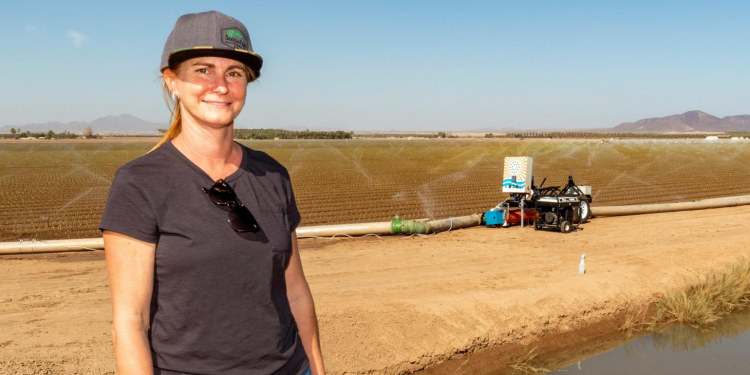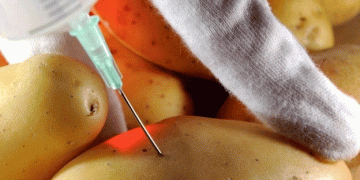As produce growers struggle to improve food safety practices and mandatory reporting, one possible link attributed to foodborne illness outbreaks in leafy greens in the past decade is being addressed in a new way, just in time for planting in the desert region of southwest Arizona and southeastern California.
As the desert landscape across the southern extremes of Arizona and California goes green under a carpet of cool season crops like lettuce, broccoli, cauliflower and a cornucopia of other commodities, farmers are setting up their irrigation systems to water these plants through the winter season where rain is scarce. One business in Yuma has developed a scalable product transported by a small trailer, but capable of fitting inside a full-size pickup bed.
Approved chemical-based water treatment systems already exist for irrigation water. This new system does not change that. While ultraviolet, or UV systems exist in metropolitan and wastewater systems geared to treat various waters, small and practical systems for the agriculture world do not because of their size and power constraints. It does now.
Paul Mondragon started Ag Partners Southwest in Yuma, Ariz. several years ago out of a passion for agriculture and technology, a move that led him to develop a non-chemical based treatment system for irrigation water that can be easily deployed and is cost-effective for growers.
Ultraviolet water treatment
Mondragon’s water system was tested by the University of Arizona and through cooperation with local produce growers. The system is now ready for prime time as at least three Yuma farmers have placed orders, with more in the works.
The system employs the same UV technology used by municipal water agencies to disinfect water from harmful pathogens. Those systems are large, and require much power, making current iterations of the system cumbersome, difficult, and expensive to farmers.
Mondragon says growers like the idea of using ultraviolet light to help eliminate pathogens in their irrigation water as they question the impacts and unintended consequences of continuous chemical usage to their soil profiles. Through these questions, and his studies that began in 2018, he now has a small-footprint, affordable water treatment product housed in a small steel chamber that connects the system to an irrigation mainline powered by a medium-sized generator.
Just in time for produce season to begin in Yuma, Mondragon’s Sunburst 12-40 system is poised to meet the Leafy Greens Marketing Agreements in California and Arizona, Type B to A, mandates, to disinfect irrigation water from pathogens with a non-chemical approach.
With UV light, water that is clear is treated through a system that the University of Arizona says can achieve 1-2 log pathogen reduction without the use of chemicals. The system will not completely replace water treatment using chemicals, but Mondragon is confident that under the right conditions it could reduce their usage while providing another means of water sanitation.
“Everything has to be portable and small,” Mondragon says, noting that portability also needed to be priced reasonably for growers. It also could not require fixed sources of power. From that he developed a system capable of running effectively with a generator of more than 8,000 watts.
The system connects to existing inline irrigation systems that move irrigation water from canals to pressurized pipe for overhead sprinklers, or with the possibility of gated pipe for furrow irrigation.
“I’m under no illusions that this is a magic bullet for farmers, but it’s another option,” he says pointing to the need for clear water with low turbidity to be most effective. For systems that cannot achieve this, he says existing chemical-based products remain as viable options. Plus, studies show that UV technology combined with low dose PPA through advanced oxidation remains another effective measure of pathogen reduction. Mondragon is also in development of an add-on prefilter to get turbidity into the 2 to 10 NTU range.
Turbidity, or the clarity of water, plays a critical role in the success of UV systems.
Harrison Farms
One of the early adopters of Mondragon’s technology farms produce on both sides of the Colorado River in southern California and southwest Arizona. Harrison has about 800 acres of vegetables on the Imperial County side of the Colorado River and about 5,000 acres of produce in Arizona.
Amanda Brooks handles food safety issues at Harrison Farms, She was on hand to watch as the system was installed next to an artisan variety of romaine lettuce in eastern Imperial County, Calif., so she could learn how to operate it and understand the data provided. She said from early on when learning about the UV system that she liked the concept for its non-chemical approach.
“One of my concerns with the chlorine-based systems is how it affects the microbes in the soil,” she said. “With this system I don’t have to worry about that.”
She continued: “When we jumped into water treatment we didn’t have years of research on what the chemical options would do to our soil profiles, but we knew we had to do something to address food safety concerns.”
Other challenges of the chemical-based approach include label restrictions that prohibit the combination of fertilizers and other crop enhancement products when treating with some of the approved water disinfectant products, she said. With the UV system, none of that is a concern. They can otherwise include fertilizer and crop protection products with their irrigation water without label restrictions.
Harrison Farms recently invested in water chlorinators, which she says the company will continue to use while they confirm the efficacy of the UV system. If that works well, she expects the company to slowly phase out the chlorinators but keep some as a backup system to ensure food safety.
Farming to Marines and back again
Mondragon’s early exposure to farming happened near the southern Colorado town of Alamosa, where he says he “learned to fix stuff, break stuff, and fix it again.” That mechanical and technical acumen led him to develop systems for Harrier jets while enlisted in the Marine Corps. His invention of systems that solved mechanical misdiagnoses in the Harrier, and eventually addressed problems with its inflight fueling system, earned him some extra pay from the Department of Defense after those systems were tested and approved.
Outside of deployment to the Middle East during the outset of the Gulf War, Mondragon’s stateside assignment was to the Marine Corps Air Station Yuma, where he continued to work on Harriers, the first military jet with vertical and short takeoff and landing capabilities. That technology evolved to later be used in the F-35, which currently operates out of MCAS Yuma.
While the Marine Corps brought Mondragon to Yuma, it is agriculture that grounds him in the community well after his discharge from active duty service.
Outside of the military presence in Yuma, which includes the U.S. Army’s Yuma Proving Grounds, the city is home to a rich farming region known for growing much of the nation’s winter vegetable crop. The production of these crops span both sides of the Colorado River from Imperial and El Centro, Calif., to locations in southwestern Arizona that include Yuma, Dome Valley, Wellton, and Somerton.






